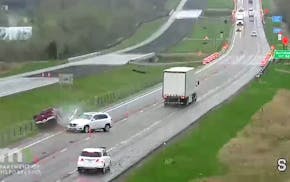Many departments of transportation across the United States use roadside electronic message boards to inform drivers how many people have died in traffic crashes for the year.
The idea behind the low-cost attention-grabbing strategy is to get motorists to slow down and drive safely.
But results from a study by researchers at the University of Minnesota and the University of Toronto published last month in the journal Science found the hard-hitting messages are having an unintended effect: They lead to more crashes.
"Good intentions do not always lead to good outcomes," said Joshua Madsen, an assistant professor at the U's Carlson School of Management. "There is something to suggest it's backfiring."
Madsen and Jonathan Hall of the University of Toronto looked at Texas where highway death tolls are advertised one week a month. The researchers collected crash data for 2 1⁄2 years before the sign campaign started in August 2012 and compared the data with the five years that followed.
They found crashes increased 4.5% in the 10 miles immediately after drivers passed a sign during weeks when the grim numbers were posted versus the other weeks of the month when the death count was not. Crashes increased each month as the death toll rose, with the most wrecks occurring in January when the grand total from the previous year was displayed, the study said.
The safety messages contributed to an additional 2,600 crashes — most involving multiple vehicles —and 16 deaths per year in Texas, costing $377 million annually, the study said.
"Our hypothesis is that people get lost in thought and focus on something other than what they need to focus on," Madsen said. The sobering numbers can steal a driver's attention and adversely impact their ability to respond to changing traffic conditions, Madsen said. "It has the ability to distract," he said.
The Minnesota Department of Transportation has displayed fatality numbers only three times since 2017, said Kristine Hernandez, coordinator of the Minnesota's Toward Zero Deaths program, which seeks initiatives to eliminate traffic fatalities.
"We have chosen not to post the fatality number, mostly out of respect for the victims' family," she said. "Most people have no idea what the numbers have been, what's 'reasonable,' or what constitutes a need for them to change their behavior."
MnDOT does post travel times and pithy puns carrying traffic safety reminders on its message boards, but they are less taxing, allowing drivers to quickly get their minds back on the road, Madsen said.
"Drivers know how to process travel times," he said. "Death can induce more anxiety than Click-It or Ticket."
Crashes spiked near signs on highways with high traffic volumes or complex segments such as in the Lowry Hill Tunnel when attention is most needed. The study suggests such signs could be useful along straight empty highways or at ramp meters where drivers have to stop.
"You can process the warning, now go drive carefully," Madsen said.

Lakeville teachers, district reach tentative contract agreement
Man who died in south Minneapolis shooting was firefighter in Eagan and Eden Prairie
I-35W northbound reopens in Bloomington after crash involving pedestrian


